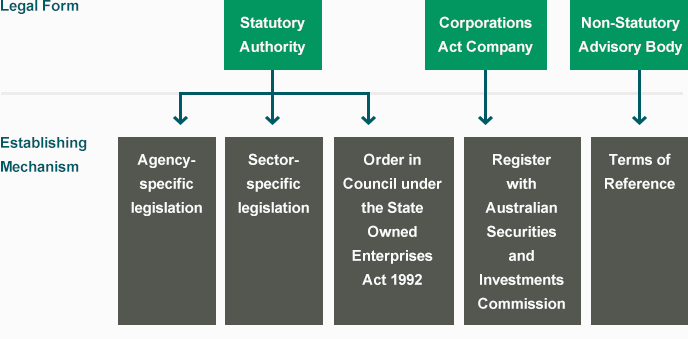2.1 Victorian Public Sector
The Victorian public sector performs a wide variety of functions on behalf of government, including directly providing services to the community, providing policy advice, collecting and administrating public money, and regulating, funding and contracting private and non-government organisations for service delivery.
These services are delivered through:
- the Victorian Public Service: departments, authorities and offices (including the VPSC)
- public entities operating in the wider public sector.
Here is the composition is of the Victorian public sector. Further detail is available in the VPSC’s annual the State of the Public Sector in Victoria report.
2.1.1 Public entities
Public entities are organisations that exercise a public function but are established outside the public service. As bodies operating at ‘arm’s length’ from government, public entities perform their functions with varying degrees of autonomy from ministers in their day-to-day decisions. Figure 2 provides the definition of a public entity.The majority of Victorian public entities that employ staff are managed by a board accountable to the relevant portfolio minister.
Definition of a public entity
Under the Public Administration Act 2004 (s5), a public entity is defined as a body, whether corporate or unincorporated, that is established by:
- an Act (other than a private Act) or the Corporations Act; or
- the Governor in Council; or
- a minister.
In addition to these criteria, the Act applies a further set of tests. These are summarised below.
- In the case of a body corporate, the Governor in Council or the relevant minister must have the right to appoint at least one half of the directors.
- The body must have a public function to exercise on behalf of the State or be wholly owned by the State.
- In the case of an advisory body, the body must:
- have written terms of reference guiding its operation;
- be required to provide the advice or report to a minister or the government; and
- be declared to be a public entity for the purposes of the Public Administration Act.
Departments and administrative offices are not public entities.
2.2 Legal form
The ‘legal form’ of a public entity refers to:
- whether it is an incorporated or unincorporated body
- the manner in which it is created – regardless of whether this is through a legislative or a non-legislative process.
The appropriate legal form for a new public entity depends on the primary function of the entity and the degree of ministerial control required. The three most common types of legal form used for public entities in Victoria are:
- statutory authority – a public entity established under Victorian legislation. Statutory authorities include entities established under their own Act, entities established under an umbrella Act (e.g. the Water Act 1989) and entities established under the State Owned Enterprises Act 1992
- Corporations Act company – a public entity established and incorporated under the Corporations Act 2001
- non-statutory advisory body – a public entity established by a minister, departmental Secretary or the Governor in Council with formal terms of reference.
In general, a statutory authority is the most appropriate legal form for the majority of public entities created in Victoria and can be tailored, as required, to suit the specific functions of a public entity.
The other legal forms have more limited application. Non-statutory advisory bodies should only be considered where an entity is being established for the purpose of providing advice to a minister(s) or department. A Corporations Act company should only be used where an entity is to perform functions with a highly commercial focus.
Figure 3 summarises the establishing mechanisms for the different types of legal form.
Figure 3: Mechanisms for establishing public entities

